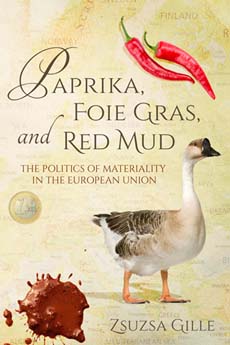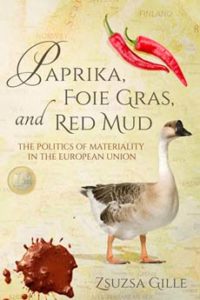
Paprika, Foie Gras, and Red Mud: The Politics of Materiality in the European Union by Zsuzsa Gille
 The three forms of materiality named in this title have been chosen because “they revealed something about the relationship between Hungary and the EU that had previously been hidden.” (3) The monograph, with its particular case studies, bring abstract categories of power relations between Hungary and the EU to the forefront. The chapters on the paprika ban, the foie gras scandal, and the red mud environmental catastrophe should help to make these power relations visible and understandable. Zsuzsa Gille has chosen a mix of theoretical approaches with the diversity of global versus local in her focus, referring amongst others to the referential book Global Ethnographies (2000).
The three forms of materiality named in this title have been chosen because “they revealed something about the relationship between Hungary and the EU that had previously been hidden.” (3) The monograph, with its particular case studies, bring abstract categories of power relations between Hungary and the EU to the forefront. The chapters on the paprika ban, the foie gras scandal, and the red mud environmental catastrophe should help to make these power relations visible and understandable. Zsuzsa Gille has chosen a mix of theoretical approaches with the diversity of global versus local in her focus, referring amongst others to the referential book Global Ethnographies (2000).
The first case study delineates the paprika-ban of fall 2004. It has been issued from the Hungarian government. There is no doubt that dried and milled red pepper is the most popular spice in Hungary, since you may find it in a huge variety of dishes. Therefore, this particular ban concerned each and every Hungarian household. The reason for the ban was obvious: public health authorities found a certain number of contaminated paprika (thirteen out of seventy-two samples) poisoned with aflatoxin B1, a carcinogenic mycotoxin. The paprika case study shows at first sight that food safety has much to do with global marketing structures, because they found out that the contaminated peppers had shipped from Brazil. Peppers from Spain and Brazil are still imported to mix it with the Hungarian grown, because they are cheaper and redder, too. In that case, Hungarianness alone is no longer a guarantee for food safety. Further, Zsuzsa Gille gives a short overview on EU-food-regulations and certifications; all together it has to be seen in combination with national standards of EU-members creating food security, environmental safety, hygiene standards dealing with the whole chain from farmers, import regulations, to food production, until the end-consumer. A few years after the paprika-ban, Hungary gained two protected designations of origin (PDO) for paprika of Szeged and Kalocsa from the EU together with protected geographical indications. PDO-regulations should at least sort the things out and help to retrieve the faith in Hungarian paprika.
So, what we can find here is a specific interplay between Hungarian national interests and standards and EU-regulations. Both should guarantee food safety for the export market, as well as regional development in the Hungarian Szeged and Kalocsa regions.
The second example delineates the foie gras boycott in 2008. It had been initiated by the Austrian animal rights organization Vier Pfoten (Four Paws) protesting against force-feeding (gavage) of geese and ducks, because it demonstrably causes pain and injuries, and the enlarged liver is a symptom of a serious disease. Prior to that, fourteen EU-countries raised a ban against force-feedingbirds. France reacted contrarily and set foie gras on a list of French cultural heritage in 2010 to forestall a general EU-ban. Hungary copied that concept and since 2012 fattened goose liver is on a list of “Hungarikum”-products selected by a commission of the Hungarian Ministry of Agriculture and Regional development (FVM) that are, in their eyes, important for the cultural heritage of Hungary. This particular chapter in the monograph discusses predominantly the accusations of Four Paws and the subsequent reactions of the Hungarian bureaucracy and of farmers, too. Zsuzsa Gille also conducted field work at geese farms in Kiskunfélegyháza. As a matter of principle, the Hungarian foie gras industry interpreted the boycott of Hungarian fattened goose liver as an attack on the national economy, mainly because it came from outwards – even the Hungarian animal rights organization Fehérkereszt (White Cross) affirmed that gavage would not be torture. Zsuzsa Gille outlines many arguments of the named parties and her personal concerns about animal welfare in Hungary. What I still do miss is that she does not raise ethical core questions like: Why does a consumer have to eat fattened goose liver at all, and why couldn’t it be easily changed to eat “normal” goose liver from healthy, adultHungarian geese?
The red-mud-spill happened in fall 2010, when 700,000 cubic meters escaped from pond number ten of the alumina factory in Ajka, northwest Hungary. It was a true ecological catastrophe that caused human deaths as well as the death of many other species in this area. Zsuzsa Gille gives a historical overview on the handling and storage of toxic waste during socialist times and later, since alone in Ajka 30 million cubic meters of red mud had been stored. During times of transition, Ajka became part of the privatized company MAL that had brought several Hungarian Bauxit and alumina branches under its wings, but profit oriented managers hesitated to invest in environmental standards, although this had been part of the privatization contract. Generally spoken, privatization in Hungary caused the fact that the protagonists at that time – and partly later on – were mired into networks where political, economic, and social power(s) intermingled. Therefore, public as well as non-governmental control mechanisms – even on such sensitive concerns like toxic industrial waste – have been much weaker than in the West. This monograph clearly points out that the management of MAL had the capital as well as the power to gain influence in state run activities. (80) After the ecological catastrophe of 2010, the investigators determined that MAL even had no specific documentation on their own red-mud storage. Furthermore, the Austrian branch of Greenpeace found other toxic elements like chrome, mercury, or arsenic in their laboratory samples. These samples had been confirmed later by laboratories of the Hungarian Academy of Sciences and Arts (MTA). It shows further that MAL profitably rented their ponds out for foreign companies to store their toxic waste in the ponds, too. The role of the EU in this case was ambiguous: to EU-standards, red mud is no hazardous industrial waste, since in standard practice the alkalinity is much lesser than in the Hungarian red mud. Moreover, most EU-alumina-companies switched to a dry technology that does not produce this sludgy red mud any longer. Since 2011, MAL also switched to dry technology that caused a new danger: because of the wind neighboring villages were occasionally covered with toxic red dust.
The fourth chapter of the book discusses questions like “what is the substance of the EU’s coherence and power?” (93) The following citation should shortly outline one of the author’s goals: “the remainder of this chapter will first lay down the foundation of sociologic approach to size and, second, look at how the scholarship on regulation – which after all is about connecting small with big things – would interpret these three case studies.” (95) Generally speaking, the EU-legislation oscillates between (too much) regulation and deregulation. We also have to see it against the background that the EU is a project that presupposes the voluntariness of each member state.. Further attention should be paid to the fact that the EU is far from being the “United States of Europe” simply because there are in present twenty-seven nation states with twenty-seven different constitutions and governments. The recent developments concerning a “new identity economy in which ethnicity is the key element” (106) also tend to strengthen the national and regional economies. In her conclusion, Zsuzsa Gille again brings “the materialization of politics” into focus. She does not only reflect on her three case studies, but also gives more examples from EU-policies and how they were construed in Hungary. I highly suggest reading this monograph. The paprika ban, the foie gras scandal, and the red mud environmental catastrophe represent three very well-selected and comprehensible cases, and they help Zsuzsa Gille demonstrate a very complex socio-political context regarding the practices of governing “materiality” to the ground. I recommend this book to undergraduates as well as graduate students studying various disciplines regarding social, ethical, legal, and economical questions about the (supra)national handling of food-security, animal-welfare, and the storage of toxic waste – topics that should concern everybody of us.
Reviewed by Klaus-Jürgen Hermanik, University of Graz
Paprika, Foie Gras, and Red Mud: The Politics of Materiality in the European Union
by Zsuzsa Gille
Publisher: Indiana University Press
Paperback / 180 pages / 2016
ISBN: 9780253019462
Published on July 17, 2017.




